(Site under construction)
Graphic designer, currently based in London. Previously at Fabrica Research Centre. Currently at BBC Creative.
Currently available for hire, project-based or fulltime. Request full portfolio
Information
Practice
Image
Projects are not in chronological order.
Copyright © 2023, Tom Heath, All Rights Reserved.
︎
Preserving
Archiving
Plotting
Recording
Documenting
Examining
Mass reproduction
Reproduction
What is Extinction to me? I’m interested in the idea of preserving / examining.
What does it mean to preserve? What does it mean to examine?
To show /demonstrate the damaging affects on the world.
Preserving, examining, presenting. Facts, figures, statistics.
Explaining the why, creating something tactile, beautiful for poeple to touch and explore with their eyes, with their fingertips.
Look at the definition of Preserving. What does it mean?
The idea of reproduction / mass production.
Timothy Morton describtion of Stockpiling.
Reproducing and declaring facts.
A loss of connection, due to the mass production of an image
The mass production of a single object removes the significance of that one object.
What is Extinction to me?
I’m interested in the idea of preserving / examining.
What does it mean to preserve?
What does it mean to examine?
To show / demonstrate the damaging affects on the world.
(I have discovered the interest in my practice; I still need to define exactly what my thinking is and progress with research. Hans-Peter Feldmann describes his practice as ‘Collecting, ordering, re-presenting’, the moment I read this group of individual words within the context of my practice my vision cleared. I went on to discover more about Feldmann and found his book ‘272 Pages’. The opening page features an extract from Chuck Berry’s autobigraphy where he describes his process; ‘First, it happened; second, I conceived what happened; third, I reproduced what I conceived; and fourth, you will conceive what I have reproduced.’)
Definition of extinction.
-
the act of making extinct or causing to be extinguished.
- the condition or fact of being extinct or extinguished also : the process of becoming extinct extinction of a species.
- the process of eliminating or reducing a conditioned response by not reinforcing it.
the process of eliminating or reducing a conditioned response by not reinforcing it.
A story/narrative, something that is read in a linear way. When reading a book, you start at the begining, develop your understanding and then reach the conclusion. It’s a process, just like learning, developing, understanding. A book is designed so you have a begining, middle and an end. Are we nearing the end of our story? The progression of life is linear.
Ecology
Ecology is the study of the relationship between living organisms, including humans, and their physical enviroment; It seeks to understand the vital conections between plants and animals and the world around them.
Matt Mullican
Matt Mullican was born in Santa Monica in California in 1951. Since the Seventies Matt Mullican’s works have been exhibited in the most prestigious museums of the world as the Metropolitan Museum of Art in New York, Haus der Kunst in Monaco, the National Galerie in Berlin, the Stedelijk Museum in Amsterdam and the Museum of Contemporary Art in Los Angeles. In the last years Matt Mullican’s works have been exhibited in many solo shows as The Meaning of Things at Spazio Culturale Antonio Ratti in Como (2013); Vom Ordnen der Welt, Haus der Kunst, Munich (2011) and 12 by 2 at the Institut d’Art Contemporain in Villeurbanne, France. Matt Mullican has partecipated in Venice Biennial in 2013, in the Whitney Biennial in 2008, in Documenta X (1982, 1993, 1997) and in the Skulptur Project in Munster (1987).
Stone Video Rubbing Wire shows a synthesis of the cosmology that Matt Mullican created starting from the Seventies; an encyclopedia made by images, diagrams, pictograms and symbols that represents omtological ideas, synthetizing the whole subjective and objective universe. The American artist brings to Milan a monumental work dated 1987 constituted by 40 granite tiles and a new canvas series, realized using the most oldest reproduction technique of an artwork, the rubbing.
Through these new works Matt Mullican represents the five worlds that creates the reality: the subjectivity, the language, the arts, the objectivity and the elements, wondering the existential questions of one’s self: “what happened before I was born?”, “Why the things happens in the way they do?”, “What happens after I die?”.
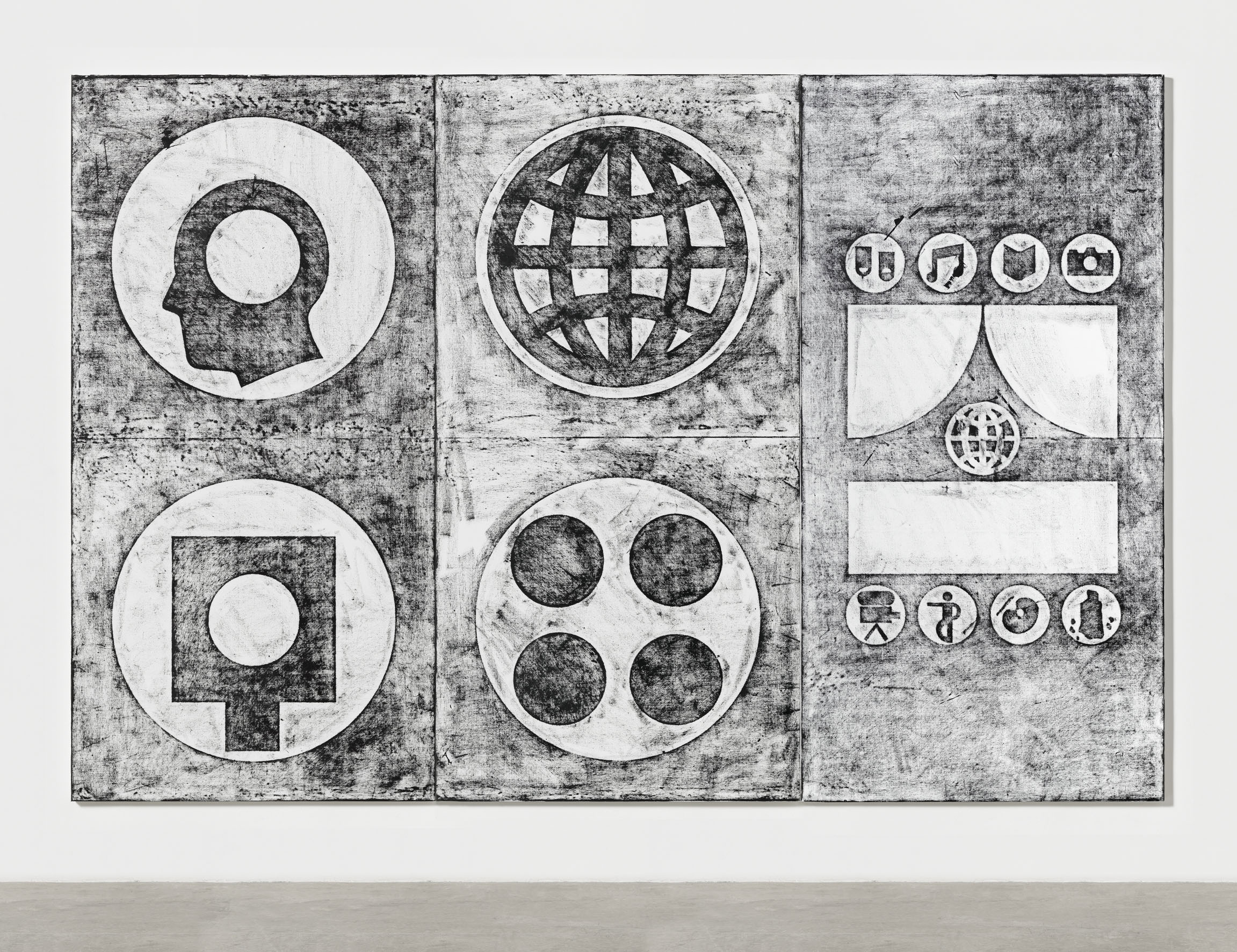
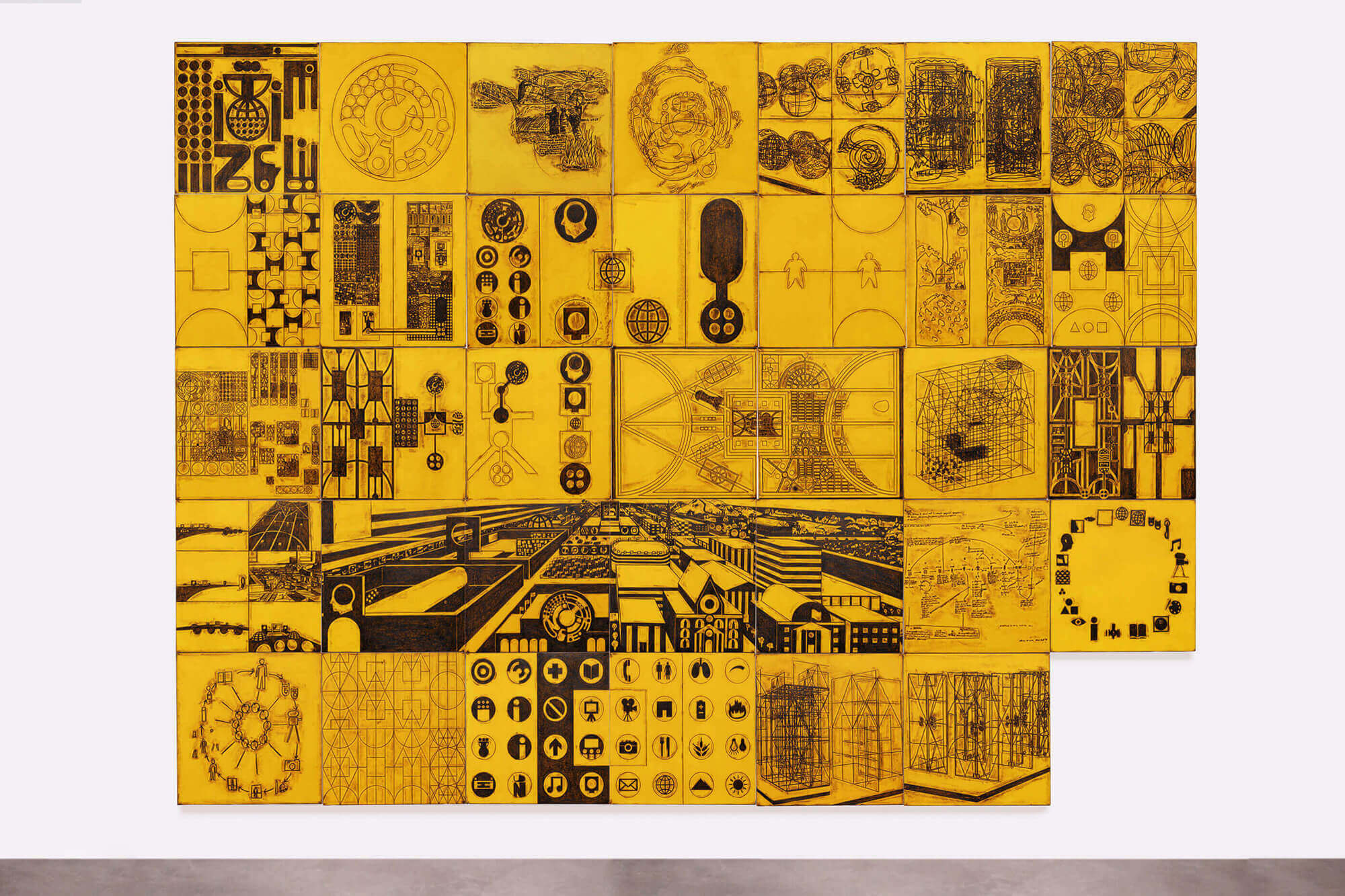
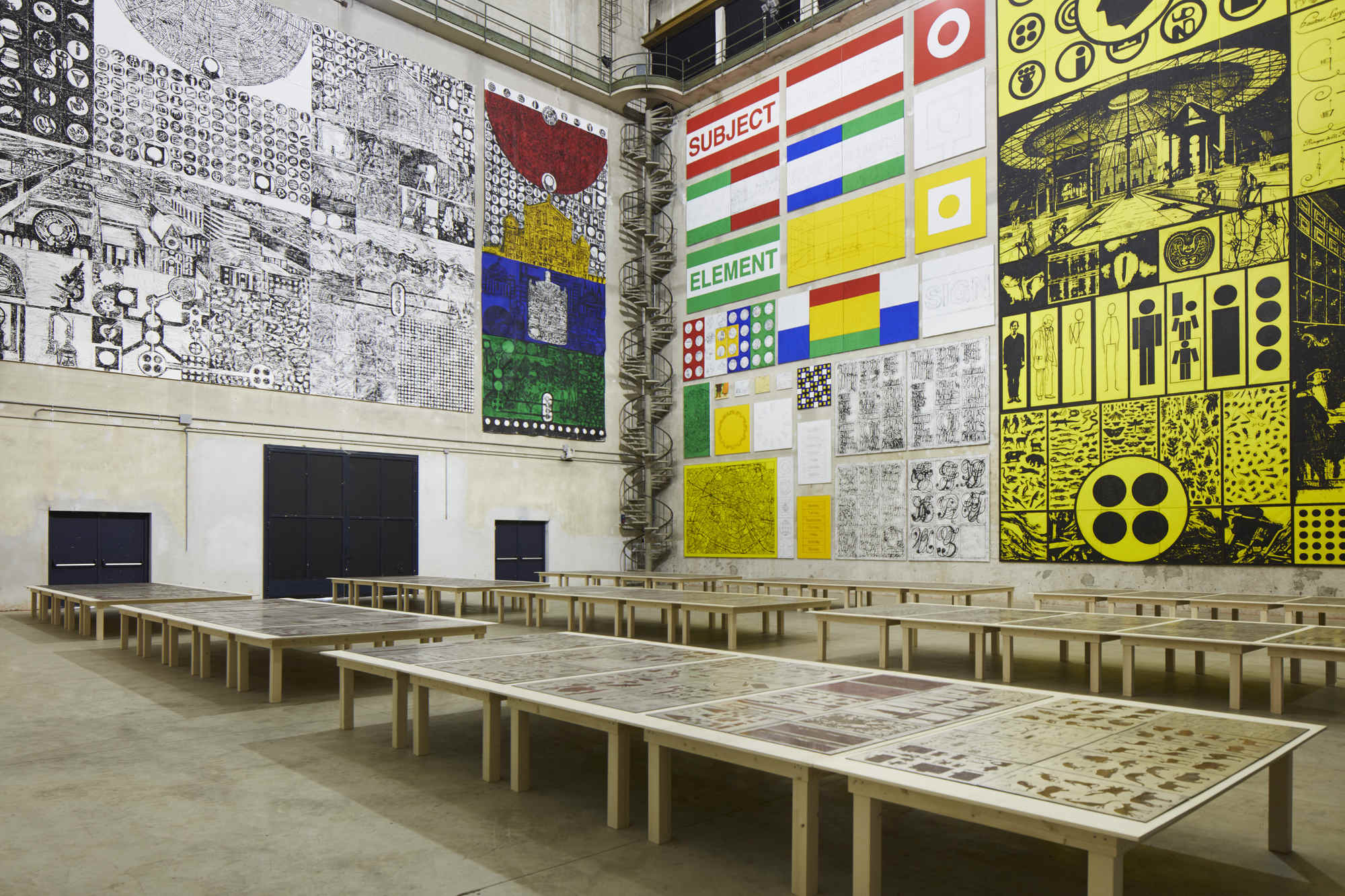
Stone Rubbing


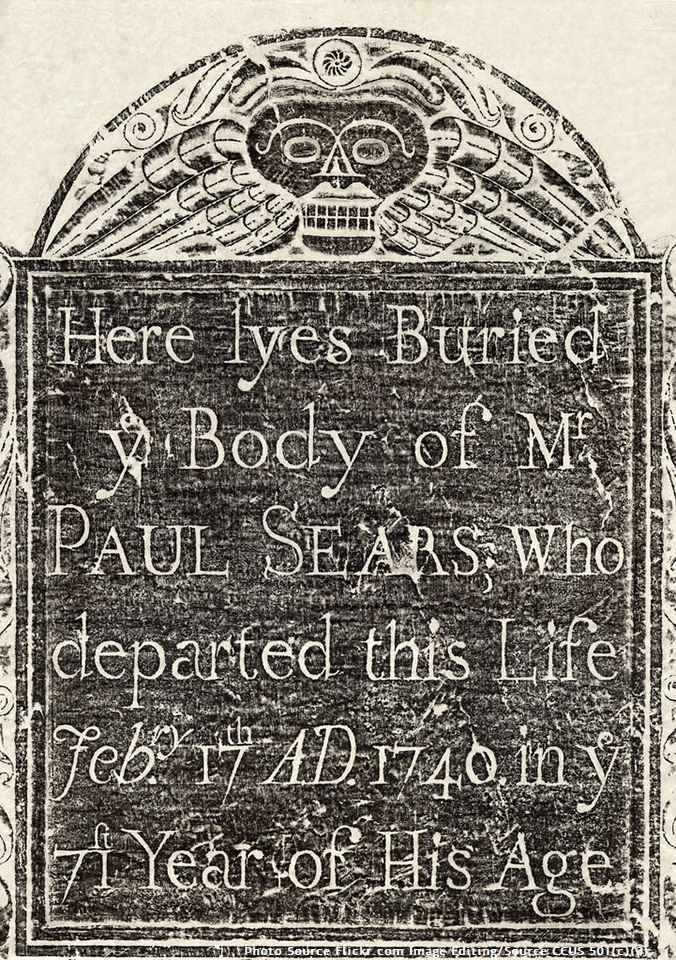
Introduction:
Stone rubbing is the practice of creating an image of surface features of a stone on paper. The image records features such as natural textures, inscribed patterns or lettering.
Task:
Over the course of the next week, choose a number of contrasting locations in order to preserve the textures and record the existence. The record should include any extra information / data deem to be necessary, i.e. location, weather, temperature, date.
Outcome:
The outcome should be a traditional A0 printed page which houses the stone rubbing of the specific location along with the data of the surrounding area. The idea is to connect with the environment (Fabrica) and explore what it means to preserve.
Think about:
-
Explore the history.
-
How can you share the story through print?
-
Where is your content coming from?
-
Think about format.
-
Who is it being created for?
-
Why are you creating this work?
-
Who can relate to this now?
-
When was it created?
-
Who’s your audience? Peers, General Public, The Government, Fellow creatives, your future boss.
-
Could it be expanded upon with additional content? Imagery, footnotes, texts, etc.
-
How does it affect a public space, how does it communicate to a community?
-
What impact can typographic choices have on the meaning behind the words?
-
What impact can colour have on the final product?
-
How are you going to document this particular place.
-
Think about readability.
-
Be expressive.
-
Be reactionary.
- Have fun. Ask for help. Get started.
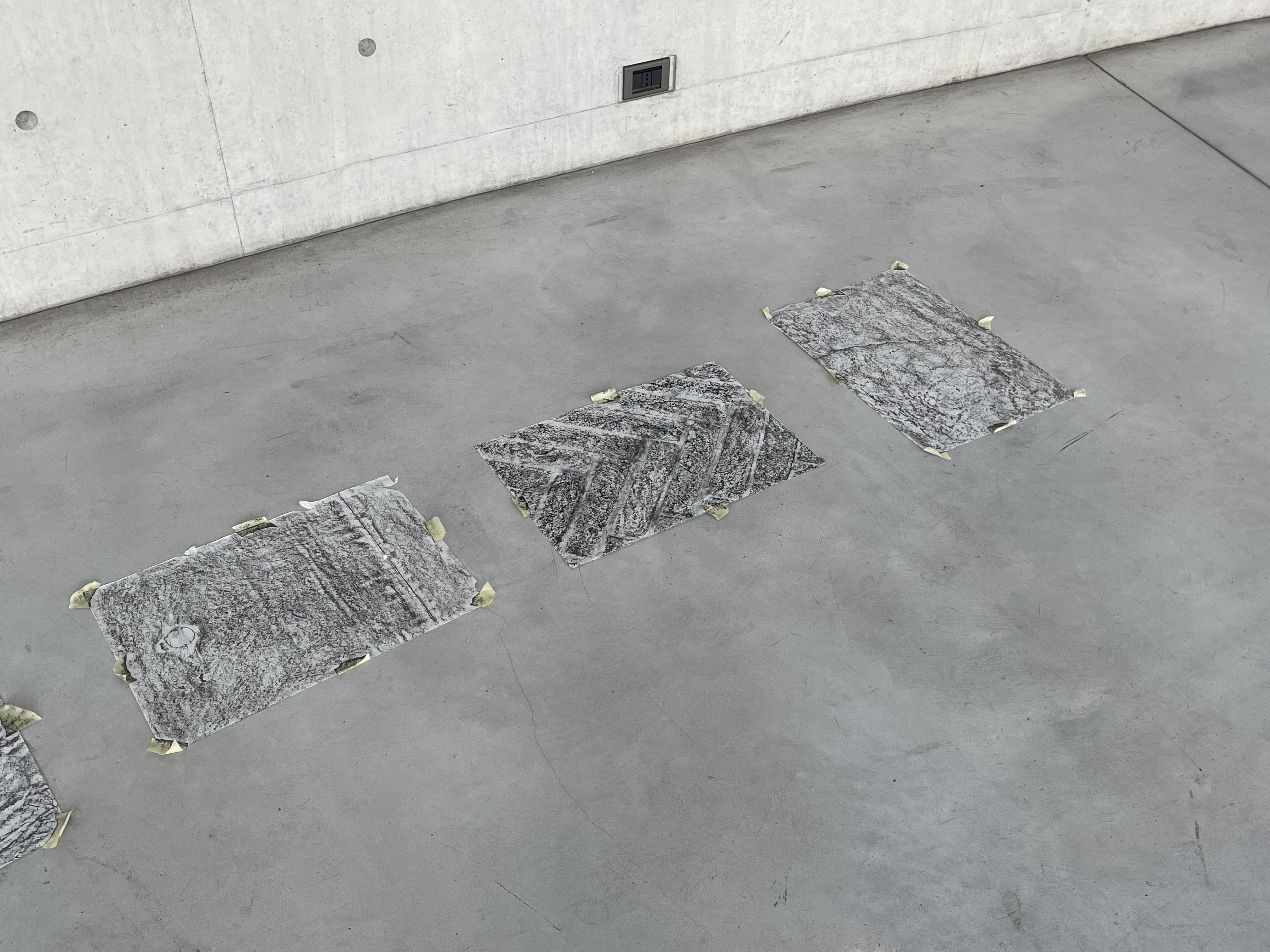


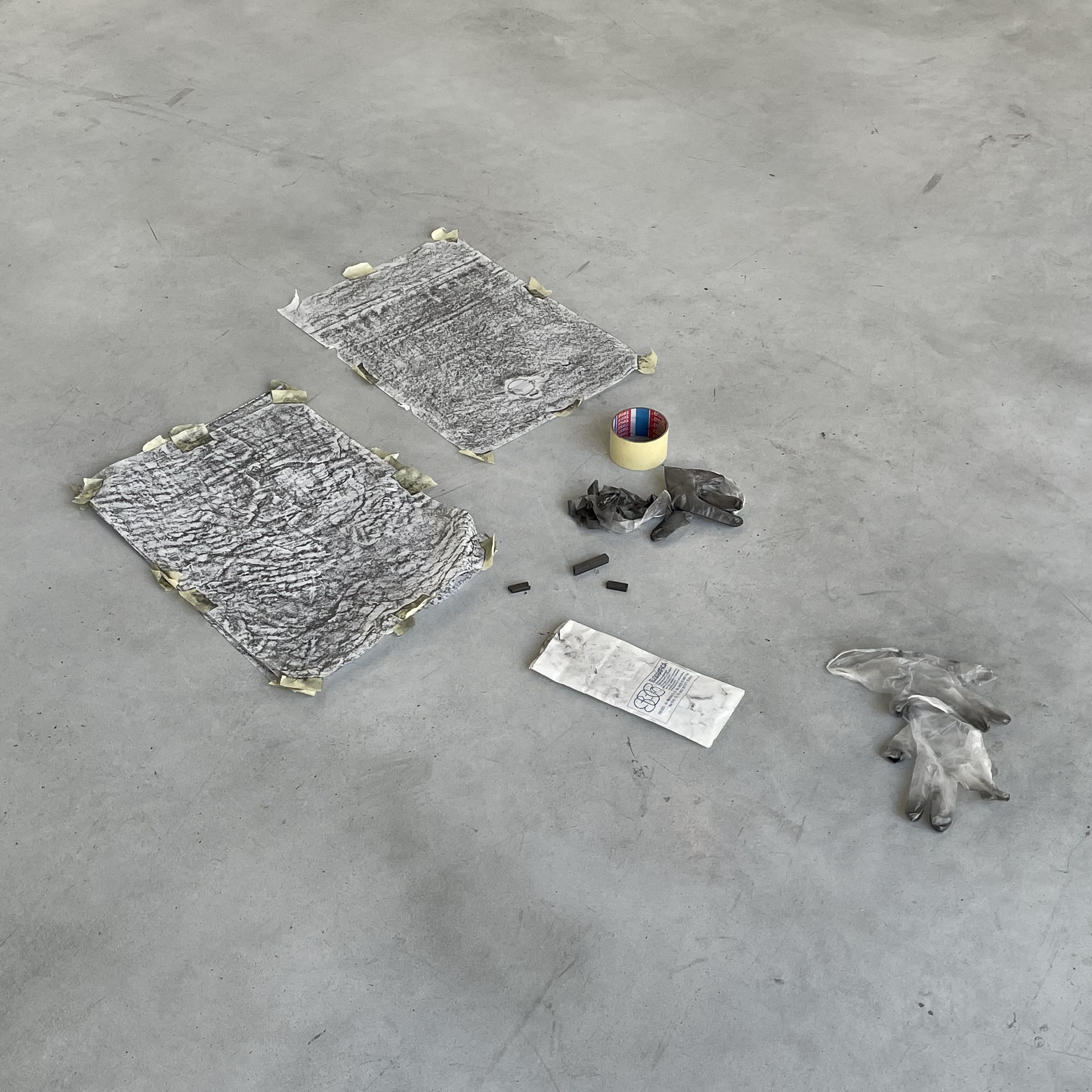

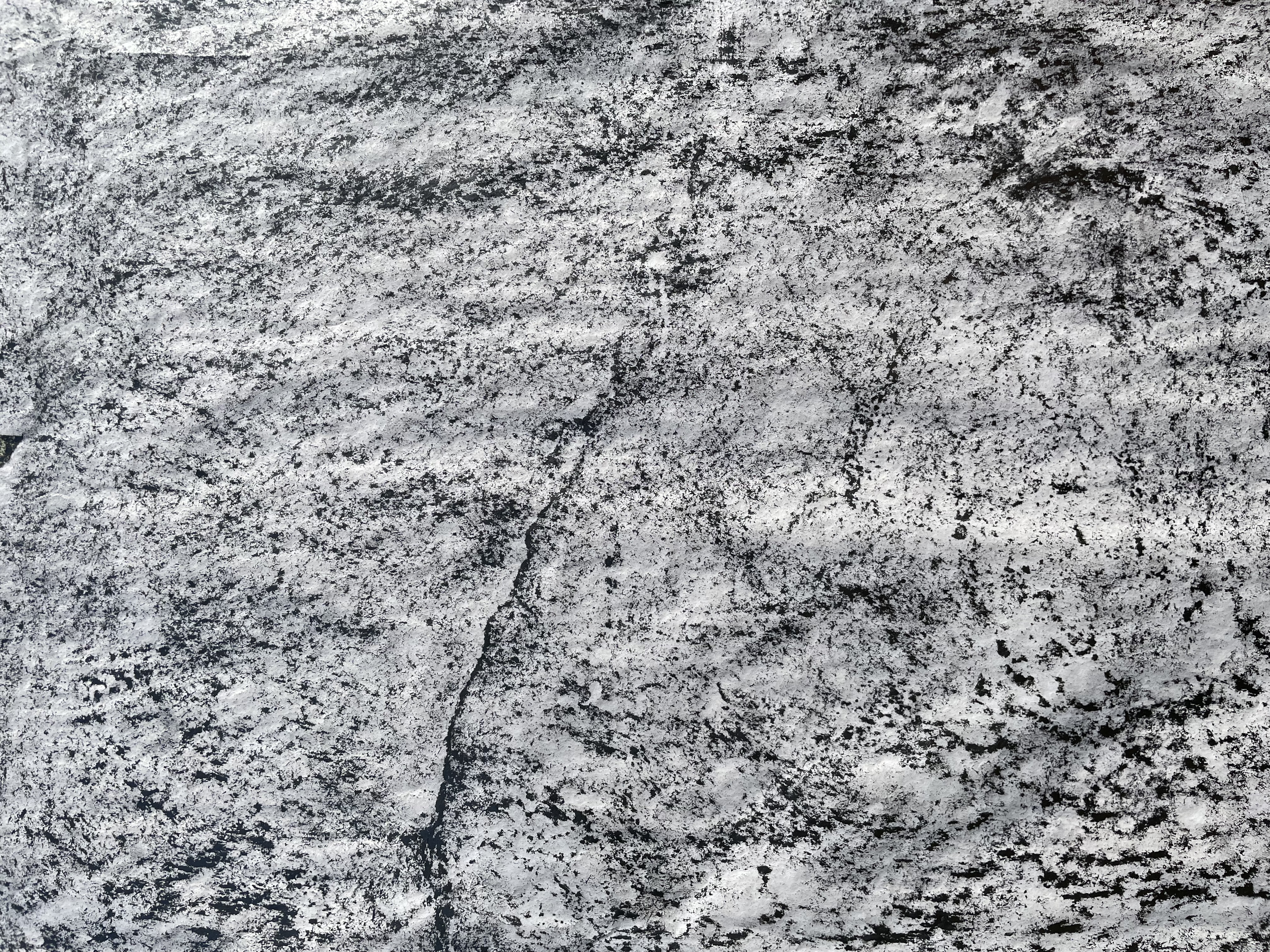
The Work of Art in the Age of Mechanical Reproduction
“The Work of Art in the Age of Mechanical Reproduction” (1935), by Walter Benjamin, is an essay of cultural criticism which proposes and explains that mechanical reproduction devalues the aura (uniqueness) of an objet d’art.
“Benjamin argues that distraction became an alternative to contemplation. Distraction is fundamentally social. It replaces the viewer’s thoughts by moving images, stopping the viewer from thinking.”
Benjamin criticises the usual account whereby true art is contemplated and the masses seek only distraction.
This echoes contemporary discussions of how media exposure reduces attention spans and may even produce stimulus overload.
The earliest works of art might have been items such as totem poles, cave paintings, and fertility dolls.
Dadaist artists rearranged everyday and artistic objects and conventions to subvert dominant assumptions.
For Benjamin, the positive aspect is inconceivable without the negative.
Film, for instance, is assigned the function of expressing supernatural and mythical phenomena.
He argues that children are now bombarded with printed letters even before they can read. The effect is that they can no longer experience the ‘archaic stillness of the book’, instead being overwhelmed by ‘locust swarms of print’ which ‘eclipse the sun’ of the intellect.
https://ceasefiremagazine.co.uk/walter-benjamin-art-aura-authenticity/
Greek Reproduction
“The Greeks knew only two procedures of technically reproducing works of art: founding and stamping. Bronzes, terra cottas, and coins were the only art works which they could produce in quantity.” — Walter Benjamin, The Work of Art in the Age of Mechanical Reproduction, 1935.
Eugène Atget
Eugène Atget was a French flâneur and a pioneer of documentary photography, noted for his determination to document all of the architecture and street scenes of Paris before their disappearance to modernization. Most of his photographs were first published by Berenice Abbott after his death.
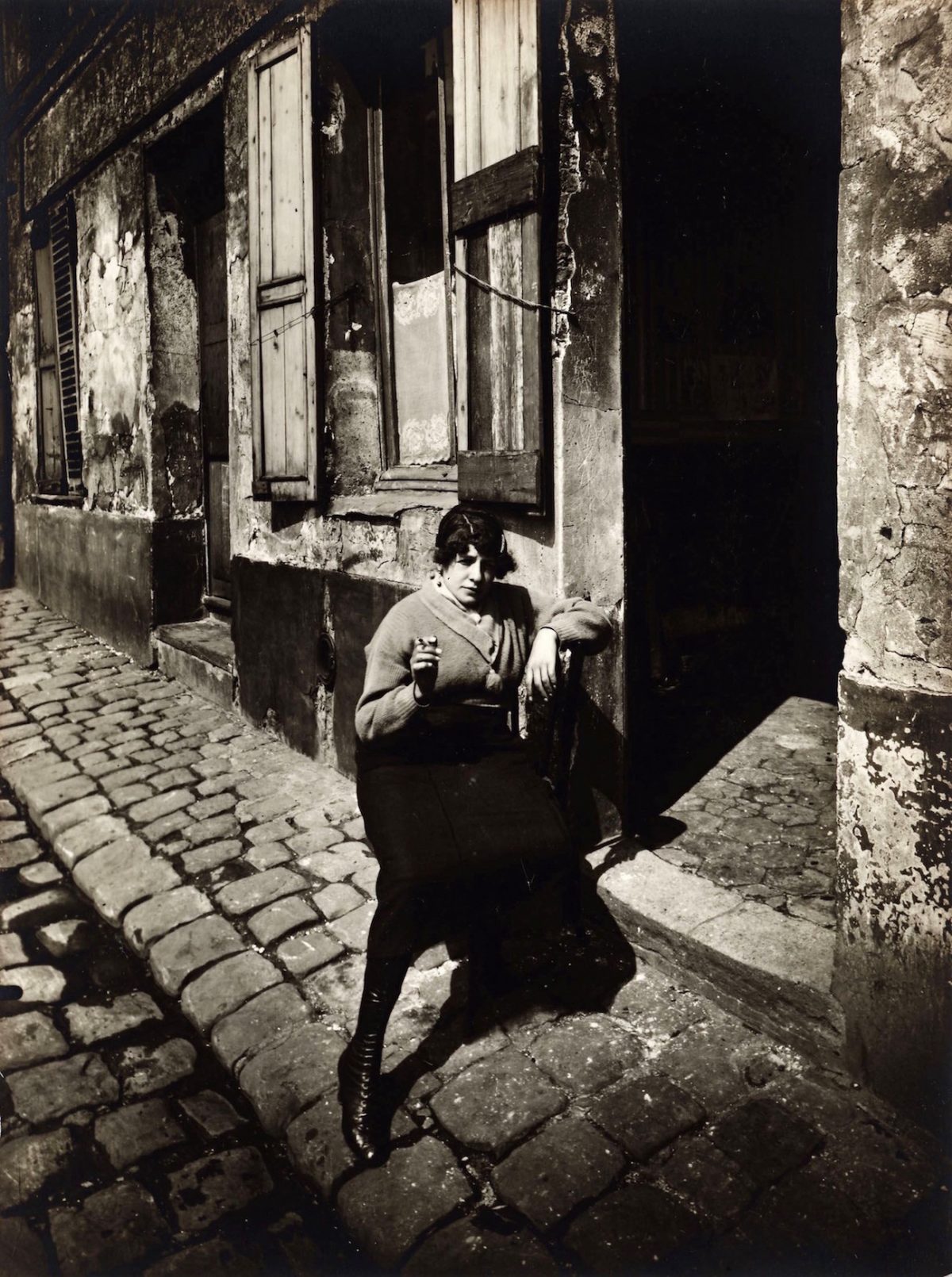
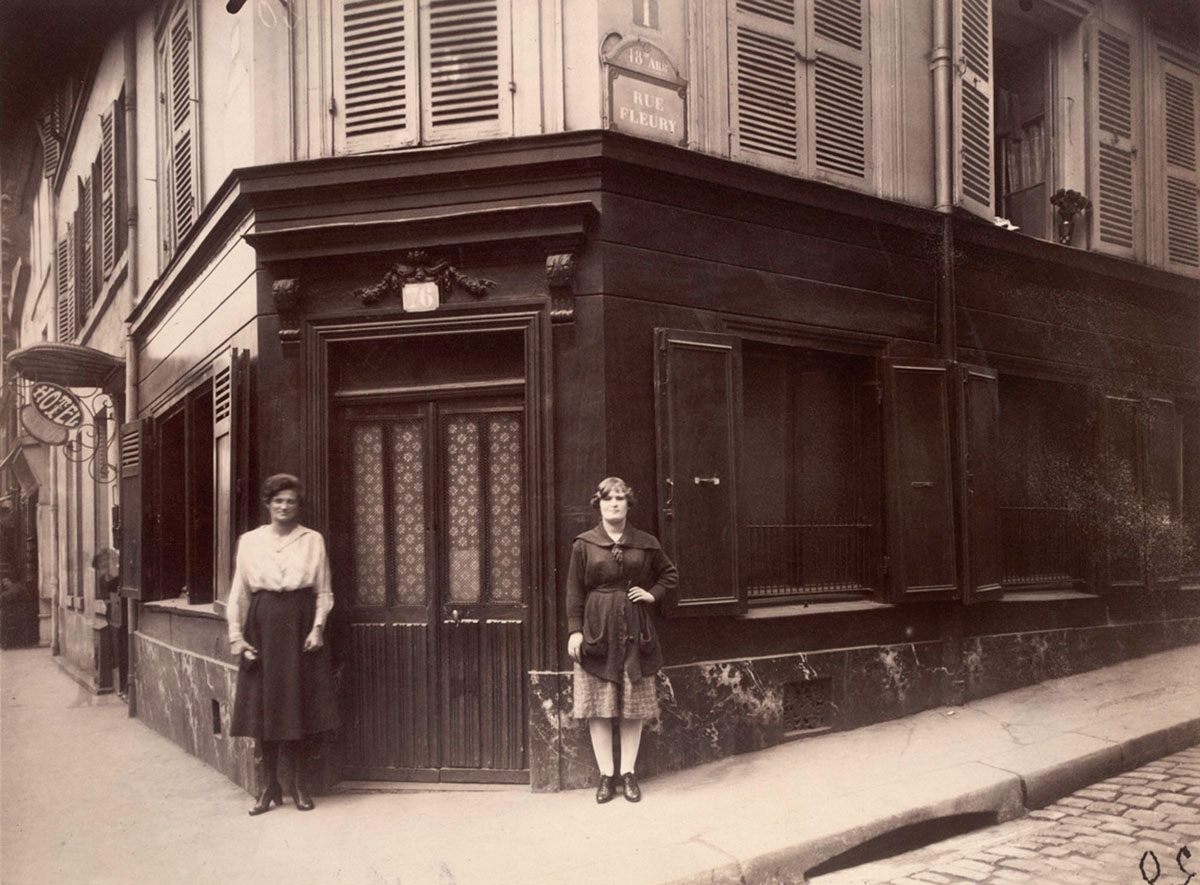
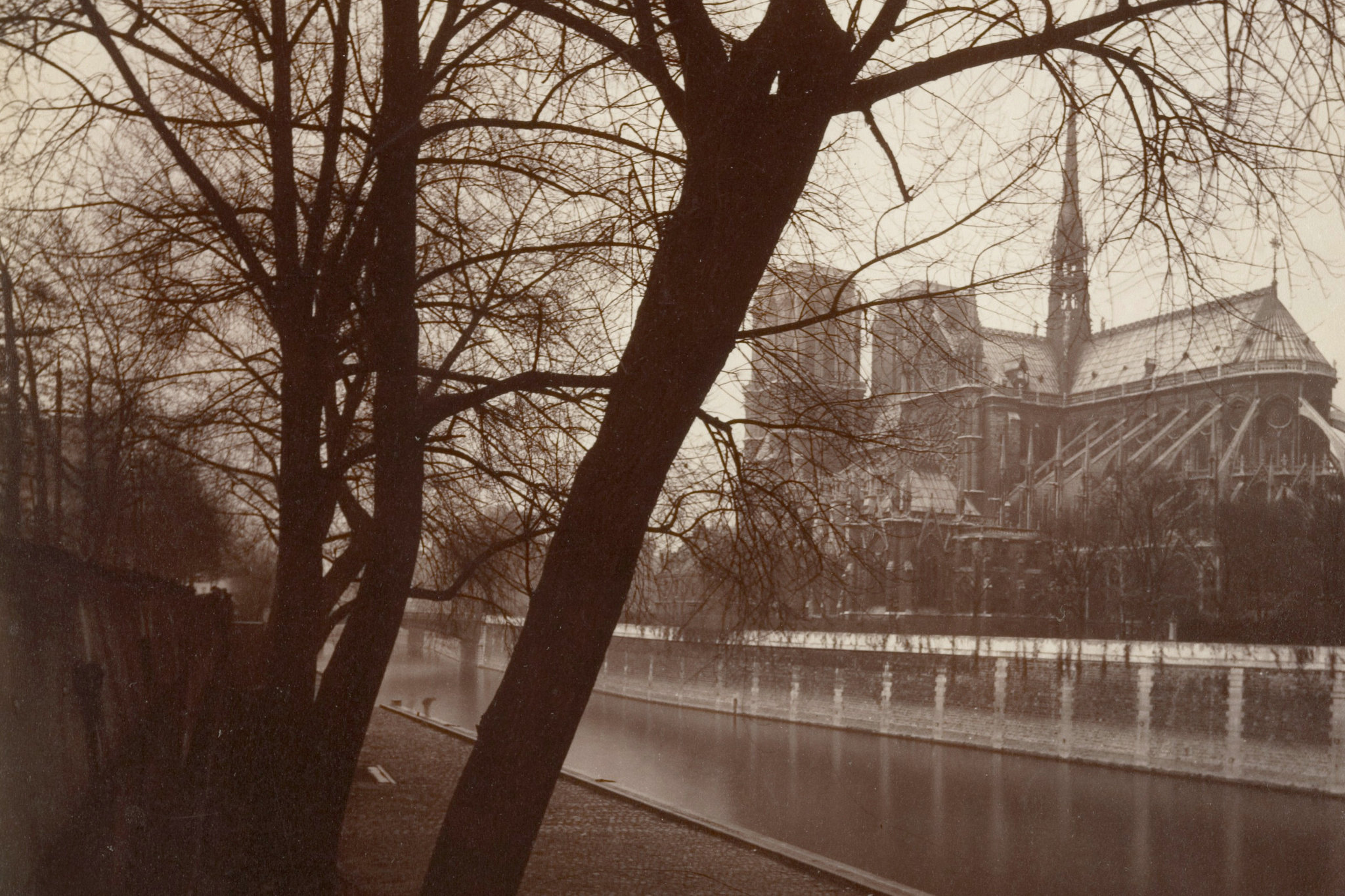
Marcel Broodthaers
Marcel Broodthaers was a Belgian poet, filmmaker, and visual artist (b. 1924 in Brussels, Belgium, died in 1976 in Cologne, Germany)
Marcel Broodthaers worked primarily as a poet until the age of 40, when he turned to the visual arts. Over the next 12 years, his work retained a poetic quality and a sense of humor that balanced its conceptual framework. Broodthaers continued to invent ways to give material form to language while working across mediums - poetry, sculpture, painting, artist’s books, printmaking, and film. From 1968 to 1972, he operated the Musée d’Art Moderne, Département des Aigles (Museum of Modern Art, Department of Eagles), a traveling museum dedicated not to his work as an artist but to the role of the institution itself and the function of art in society. In the final years of his life, Broodthaers created immersive “décors,” large-scale displays in which examples of his past work were often unified with objects borrowed for the occasion. His work, despite its brief duration proved enormously influential to future generations of artists.
Broodthaers made his first film in 1957, and from 1967 he produced over 50 short films in documentary, narrative, and experimental styles.
Broodthaers later worked principally with assemblies of found objects and collage, often containing written texts. He incorporated written language in his art and used whatever was at hand for his raw materials—most notably the shells of eggs and mussels, but also furniture, clothing, garden tools, household gadgets and reproductions of artworks.
As a poet and political activist, Broodthaers had a life-long interest in the circulatory power of printed matter: posters, graphics, editions, and artist books.

Court Circuit, Marcel Broodthaers
On the front cover of the catalogue the word Véritablement flaunts in big, bold, capital letters (Fig. 1), while the exhibition title is only mentioned on the back cover: Court Circuit. (Fig. 2) What, then, is the title of this publication? The reader might choose between Véritablement and Court-Circuit. Véritablement, meaning “truly’, ‘really’, ‘actually’, accedes with a heavy semantical load, opening boxes containing questions of truth, reality and presence. Court-Circuit, French.
In Court-Circuit, Broodthaers presented eggshells, bottles, crates—empty vessels, forms, containers. While the historical viewer visited the show and probably read the catalogue afterwards, the (art) historian today starts out with the catalogue.
This integrity of printed matter is crucial to Broodthaers’ artistic approach: being busy with writing, reading and reciting, he was not only highly aware of the value of the exhibition catalogue, but also used it artistically and integrated his publications in his artworks and installations.

Hans-Peter Feldmann
Hans-Peter Feldmann (born 1941 in Düsseldorf, Germany) is a German visual artist. Feldmann’s approach to art-making is one of collecting, ordering and re-presenting.
In the 1960s, Feldmann studied painting at the University of Arts and Industrial Design Linz in Austria. He began working in 1968, producing the first of the small handmade books that would become a signature part of his work. These modest books, simply entitled Bilde (Picture) or Bilder (Pictures), would include one or more reproductions from a certain type—knees of women, shoes, chairs, film stars, etc.--their subjects isolated in their ubiquity and presented without captions. In 1979 Feldmann decided to pull out of the art world and just make books and pictures for himself. In 1989 the curator Kasper König persuaded Feldmann to exhibit in a gallery again.
What all these works had in common whether they consisted of sent postcards, photos published in the press, giving life to an epistolary character or introducing the artist into the work itself, as in the case of the pornographic photos - was that Feldmann was creating situations, inventing a context, a new reality, and, in short, narrating, telling stories. And Feldmann believes, as does Chuck Berry, that even that which we define as real is fiction. We not only invent ourselves in front of others, we are also able to tell stories about ourselves and even to ourselves. Narrating ourselves makes it possible for us to change our situation or point of view, even to become someone else. Feldmann knows that man is a narrative animal and that narration is the ordering of the chaos which is life, giving it a structure which enables us to see it.
When he uses written or spoken lanuage to make his projects, Feldmann defines them as “images constrcuted through language”. And on occasion he has exhibited them in the type of frame normally used for family snaps. Sometimes, his exhibitions have consisted over only a few sheets with text stuck onto the wall. When read, these texts form a mental image in the mind of the spectator, and it is this image which is being exhibited.
Feldmann’s use of language includes words, sometimes combined with images, as in his public talks, which are half way between a lecture and a performance. In his talks, by means of images and phrases, he points out the notions associated with our uses of the photographic image, highlighting the way in which we give power to an image by reading it through our beliefs, desires and dreams despite the fact that we know that photographs are simply a piece of paper.
We put objects together in order to know the world and also to build worlds of our own.
Collecting gives meaning to and domesticates the desire to have.
Creating situations, inventing a context, a new reality, and, in short, narrating, telling stories.
collecting,
ordering,
re-presenting.

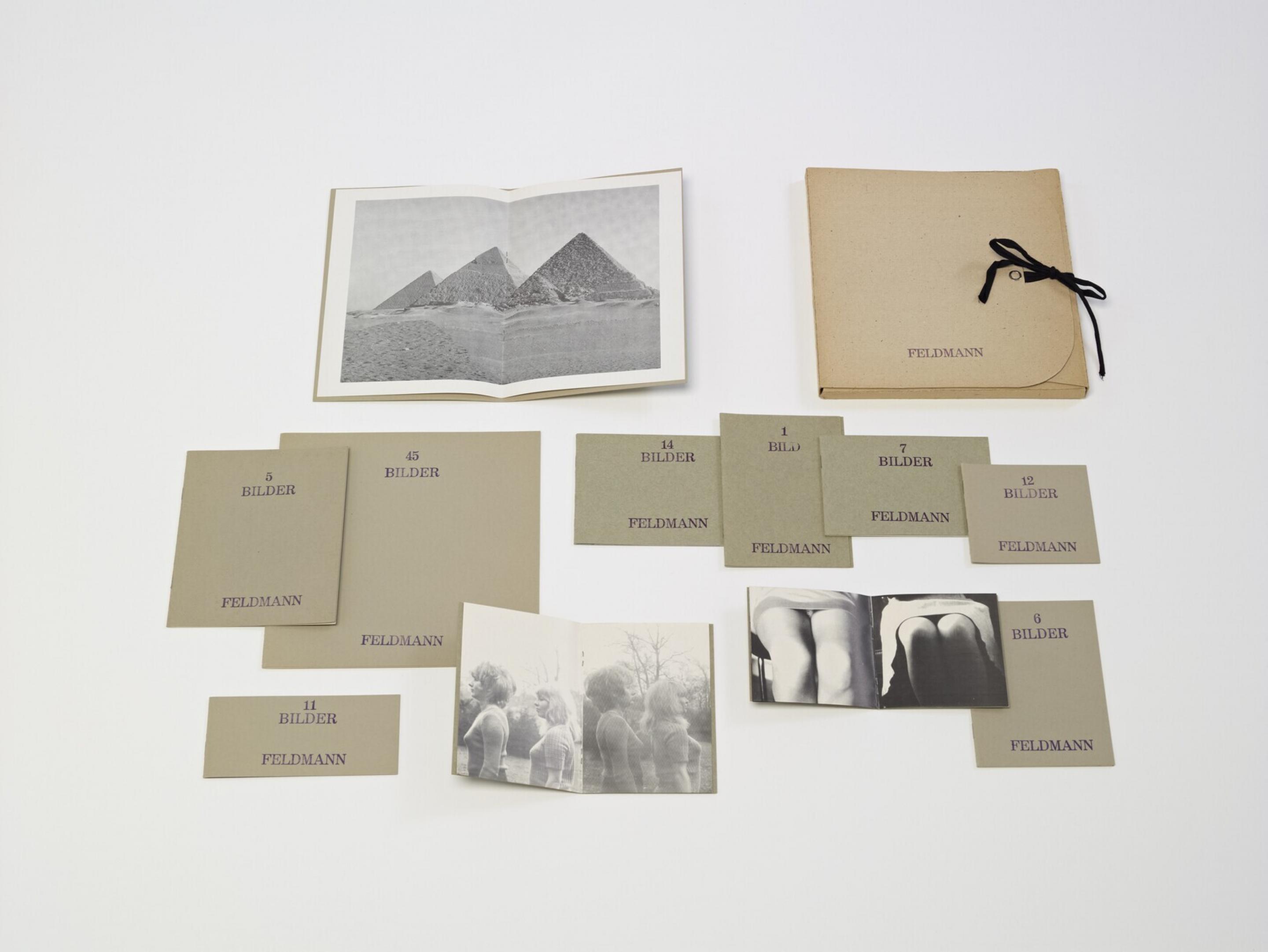

Susan Stewart
Susan Stewart, On Longing: Narratives of the minature, the gantic, the souvenir, the collection (Durham: Duke University press, 1993). This is what Feldmann is intrerested in, exploring this space: the distance between what things are and what they mean.
“It is in this distance between what they are and what they mean, in this open space between the signifier and the signified, that the symbolic order is generated within which the collection constitutes itself as a narrative, and, therefore into a structure of desire, which has to do with nostalgia.”
Henri Lefebvre
“The human world is not defined only by that which is historical, by culture, by the whole of society, by ideological superstructures and politics. It is defined by this intermediate and mediating level: daily life. Here we can observe the most specific dialectic moevements: necessity and desire, to enjoy and not to enjoy, satisfaction and privation, achievments and failures, work and non-work, the repetative part and the creative part.” Henri Lefebvre
Chuck Berry, The Autobiography
Just remember, my accounts of actions I’ve experienced are the fourth generation of communication. First, it happened; second, I conceived what happened; third, I reproduced what I conceived; and fourth, you will conceive what I have reproduced.
Danh Võ
Võ’s installations, which are composed of documents, photos and appropriations of works of other artists, often address the issues of identity and belonging.
Emerging from personal relationships and fortuitous encounters, Vo’s projects take their final form as objects and images that have accrued shifting layers of meaning in the world...

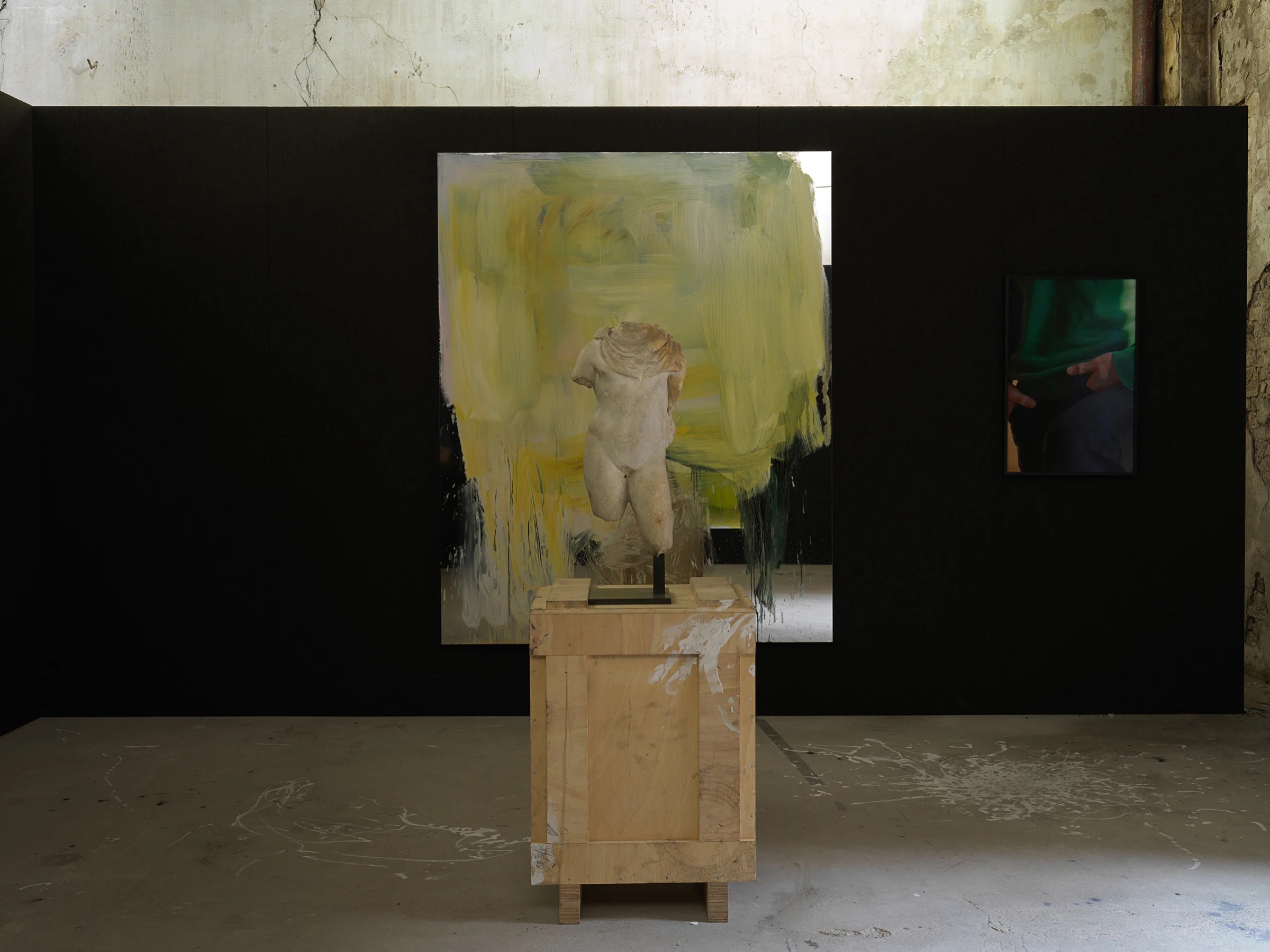

Photographic work presents research and works from various projects by the artist Heinz Peter Knes (*1969, Gemünden am Main) and places them in a new relationship to one another. The solo exhibition includes excerpts from Knes’ photo archive, film material and text. The photographic process unfolds on the wall: photos form clusters, are removed from their original context and generate a series of formal, social and political narratives through new constellations. Three stations run through the room, in which historical material is broken down into its levels of meaning and can be read along the term “work” with a view to political action. Knes visualizes ephemera from Hannah Arendt’s archive, deals with the photographs from the monument ensemble of the Marx-Engels-Forum in Berlin, in which the struggles of the working class are told, and considers Tilman Riemenschneider’s work at the time of the Peasants’ War. Partly originally created as book projects, this material is being deepened for the first time in the exhibition context.
Which indicators determine the photographic perception and how are they interpreted? Through the collection of material, Knes focuses on the production, showing and reading of images and their effects on collective visual memory. Research and process are disclosed and photos are taken out of a formal reading. They are images that work themselves and act on the level of objects and processes.

Tim Ingold
https://www.youtube.com/watch?v=dvVxhIquYoo
Jan Dibbets


Observing
- Geological
-
Archeological
-
History
-
Memories
-
No.13 colours mag cosmological journey
-
Obsessive archive / always a thread
-
What deserves to remembered / forgotten
-
Memory / Collective memory
-
Fabrica architect Tado / Japanese measurements
-
Everything based around the Monolith
-
Embodiment of a place
-
History
-
Carbon copy / carbon printing
-
Ian burns
-
The extinction of Memory?
-
Winfired Georg Sebald “Our relationship with history...” Loss of memory
-
Issue 51 of Colours — Solitude at the end of the world.
-
Toni Cokes
-
Think about Memory
-
Exploring and documenting my personal connection with the earth. My need to observe and to explore history. Presenting history as a memory.
-
The extinction of memory: Removing the evidence, removing the memory. Burning something? A book? Documenting this process by photography the decay and the disruption
-
The scale of removing — from the smallest scale, picking something out of the ground like a stone or digging a hole in the sand, to blowing up quarries, nuclear war
-
The brightness and darkness of an image: a single image with the brightness turned down one notch at a time until the image is revealed and then the same but opposite until the image disappears
-
Sunrise through to sunset / sun rising and then the same video in reverse (sun setting)
-
Beginning and an end
-
Memory is ethereal
- Godfrey Reggio: He had a message to tell / looking at contrasts
Memory could be an interesting angle to take with extinction. What is memory, but an impending and continuous reminder of the past. Memory can take on many different forms, such as; good memory, bad memory, memory that has never lived (de ja vu), future memory, memory as story, physical memory, fantasy, memoirs (of an historical event or biography written from personal knowledge) .
Memory is an important reminder to remember.
If we’re not careful memory will be the only thing we have.
Time is memory, memory is an archive – time is personal.
Memories emerge from personal relationships and fortuitous encounters
Why do we archive?
What are archives made for?
Why do we have the need to document?
The archive of human disaster
The Sky On Location (1983) dir. Babette Mangolte
https://www.youtube.com/watch?v=bTAjZh-dgP4
56:37
The forces of nature are there, magnified and made visible above the ground. You see modifications, dynamic events, turmoils, you see a landscape in process, a happening. You witness the destruction and the reconstruction in endless cycles. You hear sounds like machinery in an otherwise silent winter, the moist air warms you up on that cold day. It is snowing, but you don’t see it, your skin is all sticky. You look now in order to remember as you remember today the rainbow colours of last summer and you see nature as events, not scenery. Events which are outside of man and not provoked by him and you also remember that reverence for nature came only with the realisation that nature could be lost. It is this consciousness of destruction this Arriere-pensee of quick and inevitable changed that gives so peculiar a character and such a touching beauty to the solitude of America. One see them who is a melancholy pleasure. One is in some sort of a hurry to admire them both … in 1831. In that same hurry, we take data and document where we are and what we do and what nature is doing. we accumulate photographs and records to compensate that sense of irremediable loss for the passing traveler. Is it just a loss of having to go, move on, or is it a realisation that this environment is so alienate it from the concrete jungle we came from we keep on asking. Is it like last year, is it always like that. We keep coming up with the same answer, surprise and bewildered anger because weather and nature don’t repeat themselves with predictability. We can see. We ask ourself, is man ever at piece with the landscape? As an image and a painting maybe, as an abstraction in philosophy maybe, or as a backdrop for our own fantasies, but the backdrop is constantly shifting and we worry, we will like it to be permanent, we would like to own it, either mentally through memory or concretely through pictures, we would like to have it with our being there and when we are there we experience a certain pleasure mixed with guilt because of our separateness from a landscape and reconciled.
In looking at nature, I was taking down history I asked myself, have I been standing up too close or back too far. Have I really seen?
Barbara Novak “Nature and Culture”
56:37
You witness the destruction and the reconstruction in endless cycles.
You look now in order to remember as you remember today the rainbow colours of last summer and you see nature as events, not scenery. Events which are outside of man and not provoked by him and you also remember that reverence for nature came only with the realisation that nature could be lost.
We take data and document where we are and what we do and what nature is doing. we accumulate photographs and records to compensate that sense of irremediable loss for the passing traveler.
We ask ourself, is man ever at piece with the landscape?
We will like it to be permanent, we would like to own it, either mentally through memory or concretely through pictures, we would like to have it with our being there and when we are there we experience a certain pleasure mixed with guilt because of our separateness from a landscape and reconciled.

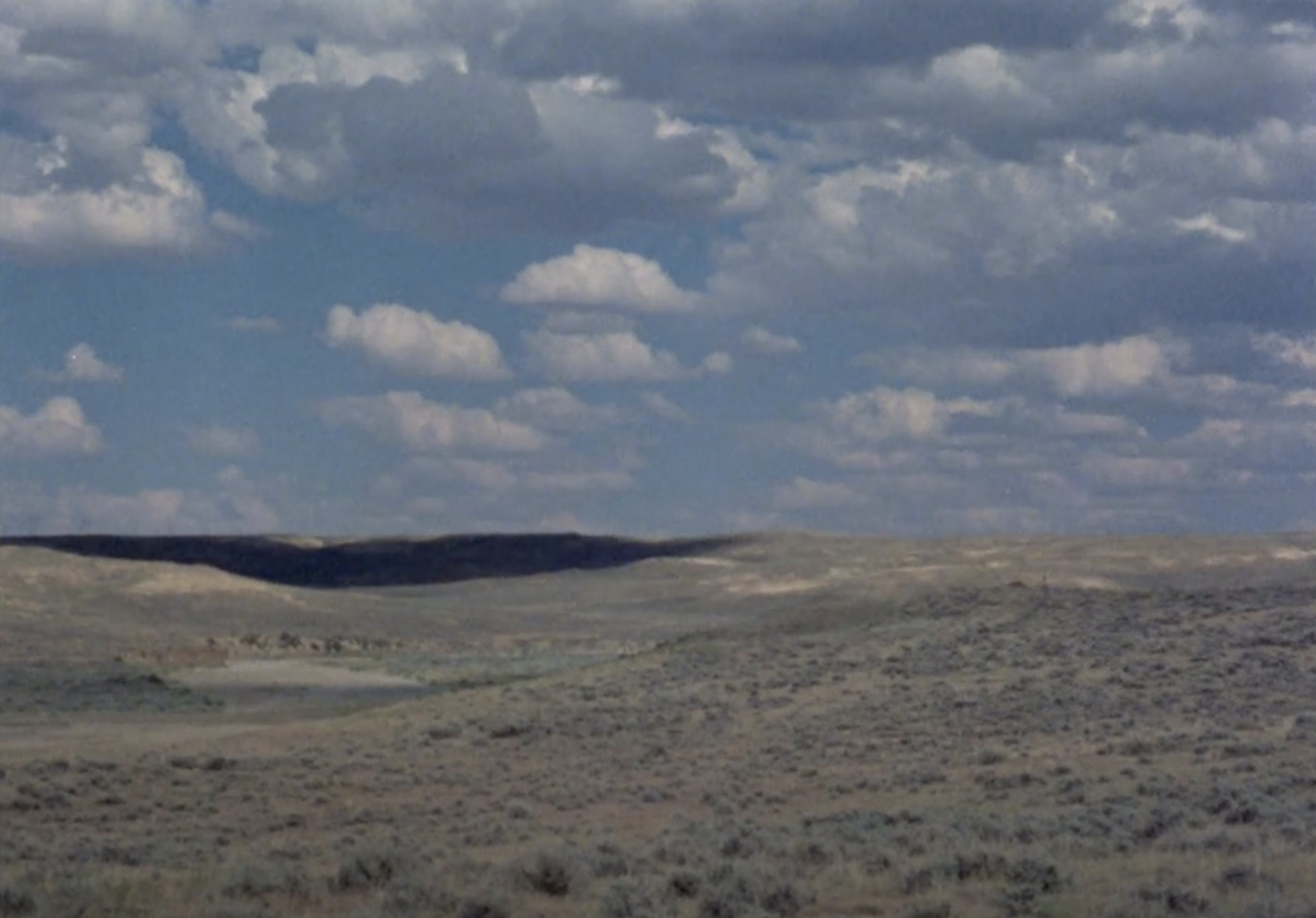
Carmen Winant
Women’s blueprint for survival (2), 2022, sun-bleached construction paper, painter’s tape, inkjet prints, 47 ½” x 36” Carmen Winant


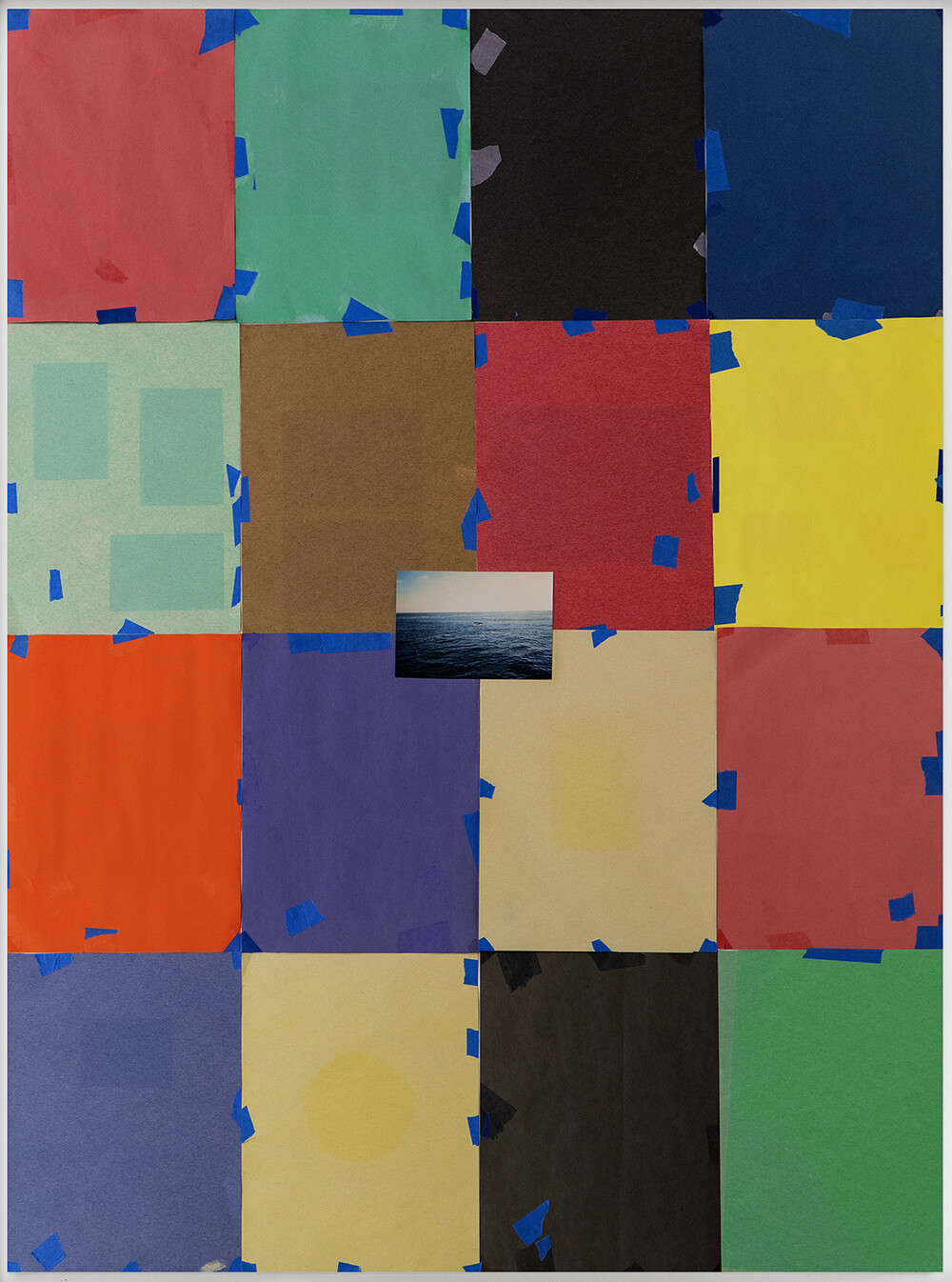
Walid Raad
Walid Raad is a contemporary media artist. The Atlas Group is a fictional collective, the work of which is produced by Walid Raad. He lives and works in New York, where he is currently a professor at the School of Art at the Cooper Union School of Art.

Scar
I took this image, as I was walking Clent Hills either by myself or with my family. A black, ring, burnt into the ground presumambly left there by a camp fire made by people. The contrast of the green and black made me stop and photograph. A constant reminder of human error and the total lack of respect we have with the landscape we walk. The balck, ring, burnt into the ground is a memory, a reminder we live here, a human-made scar.

Landscape—A Review with a European Perspective by Katia Talento, Miguel Amado, Josè Carlos Kullberg
James Corner, landscape architect and theorist, who sustains that there is one apparent topic that unifies all of the fields of landscape, elaborating a single theory: the landscape imagination. According to his thesis, there is nothing natural about landscape: even though landscape invokes nature and engages natural processes over time, it is first a cultural construct, existing as a product of imagination. Landscapes are initially imagined and represented in images, words, and projects afterwards. Like music, landscapes are forged by the imagination, while also themselves provoking and stimulating the imagination to see and figure new things.
Pursuant to this theory, landscape is always seen as the result of an architectural project that stimulates the mind. It is wrong to make the landscape coincide with nature, because, like a garden or a beach, it is not a landscape, but simply, an already existing scenario that is not linked to any architectural project.
On the contrary, the philosopher George Simmel states that the landscape exactly derives from nature, being a part of nature itself, an attractive nature that sensibly shows itself in the aesthetic experience. In this way, the thought of a French philosopher Paulhan is also aligned. He states:
“We like the landscape because we like nature, and the landscape is the portrait of it”.
Differently, the verses of François Amiel, “Le paysage est un état de l’ âme” (Landscape is a state of the soul), suggest a romantic vision of the landscape and the attention towards the interior landscape. It is a reflection of the gaze on the world of each individual, a purely subjective vision that is linked to the existence, to memories and emotions that are connected to the landscape. Our past is shaped by the constant presence of that landscape, being formed by people, things, and imagination, always alive in the unfolding of the experience. The emotional bond between people is certainly crucial and indispensable, but the relationship with the significant entities of the landscape is also essential: the horizon of the sea, the smell of a neighborhood, or a particularly significant road.
The cultural landscape is generally understood as one that man has transformed, directly or indirectly. Humboldt sustains that, in addition to the reciprocal relationship that is established between a territory and its inhabitants, it is the fact that a human being observes what surrounds him and based on that builds an image that transforms the environment or territory into landscape.
The study of the landscape is almost a seduction exercise: dismounting to perceive, finding the marks of time, the vicissitudes of history, seasons, fields, forms of settlement, buildings, and materials. More than just a concept, the study of landscapes identifies itself with the object of study of geography, the distinctive element of a clear disciplinary positioning between the natural and the human sciences.
The theory of an Italian philosopher, Rosario Assunto, is also included in this area and it describes the landscape, starting from some geographical elements. In his opinion, the definition of landscape can be enunciated, starting from the clarification of the meanings of three essential words: Landscape, Territory, and Environment, which today are used almost interchangeably.
Rosario Assunto: three essential words: Landscape, Territory, and Environment, which today are used almost interchangeably. However, the terms are quite distinct: “Territory” has an exclusively spatial meaning; in fact, it is roughly understood as an extension of the earth’s surface that can be delimited according to geophysical divisions or political-administrative delimitations (substantially territory is matter). On the other hand, the concept of “Environment” has two meanings: a biological one, which refers to the conditions of physical life, and another historically-cultural one that refers to customs and traditions. Substantially, it is the content that includes the “Territory” in itself, because there cannot be environment without territory. The definition of “Landscape” spontaneously emerges as a form that the environment confers on the territory, or rather, the form in which the synthetic unit of matter (territory) and the function of content (environment) are expresse. Substantially, the landscape for the author is “the country considered from the artistic point of view”.
However, the landscape is not just a physical element, but in fact it exists because there are those who look at it, giving it a meaning. It is an encyclopedia whose reading capacity depends on the cultural level of the observer, as an anthropological interpretation of socio-ecological facts and processes: environment, history, and geography.
Consequently, the landscape is the artificial result of a culture that perpetually redefines its relationship with nature, in which the subject is entirely part of it. In this way, we witness the birth of the social factor of the landscape, which begins with the human whose activity leaves traces on the territory.
Denis Cosgrove, an American geography professor, describes the two possible attitudes that man implements towards the landscape and leads them to two ideal typical figures, the “Insider” and the “Outsider”. The insider is the rooted inhabitant who has knowledge of places based on the memory that is transmitted by the group and on his personal memory; he produces the landscape by living it and working in it. On the other hand, the outsider, such as a tourist, is an external and disinterested spectator who has knowledge of places based on instant fruition, predominantly aesthetic; it does not produce landscape, if anything, it consumes it. For the two groups, the landscape has two different functions: for the first group, it is the transmission of identity and for the second group it is the recreation. Nevertheless, it is crucial to answer who, in our society, is a rooted inhabitant, and who is only a disinterested tourist.
Consider Earth as a single house that must be taken care of; or even as a single garden, of which the man is the gardener, which highlights the global sense of the landscape.
“Only when I saw the Earth from space, in all its ineffable beauty and fragility, I realized that the most urgent task for humanity is to take care of it and preserve it for future generations”. S. Jahn, December 2007, National Geographic Magazine.
Although we can provide innumerable definitions of the landscape, according to the theory and the social component, there is a formula that could summarize all of them:
L = S + N
In the expression above, there are three essential factors described, of which a landscape is composed of: the subject, the nature, and the relationship between both.
“In the flesh of the landscape all the stigmata of the past are impressed and endured. Landscape is a memory and I can interrogate it”. M. Corajoud in B. Cillo, 2008, p. 87W
Folkpile
-
Badbury Rings
-
Beacon Hill Hillfort
-
Caslerigg Stone circle
-
Easter Island
-
Fertility and Fecundity
-
Folkpile-Found
-
Folkpile-Found 2
-
Malvern Hills
-
Newgrange Monument
-
Stonehenge
-
The Long Man
- Uffington White Horse



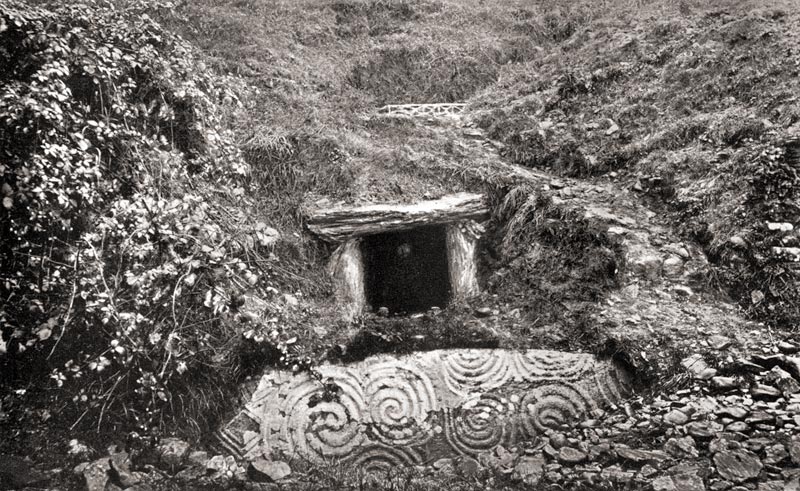






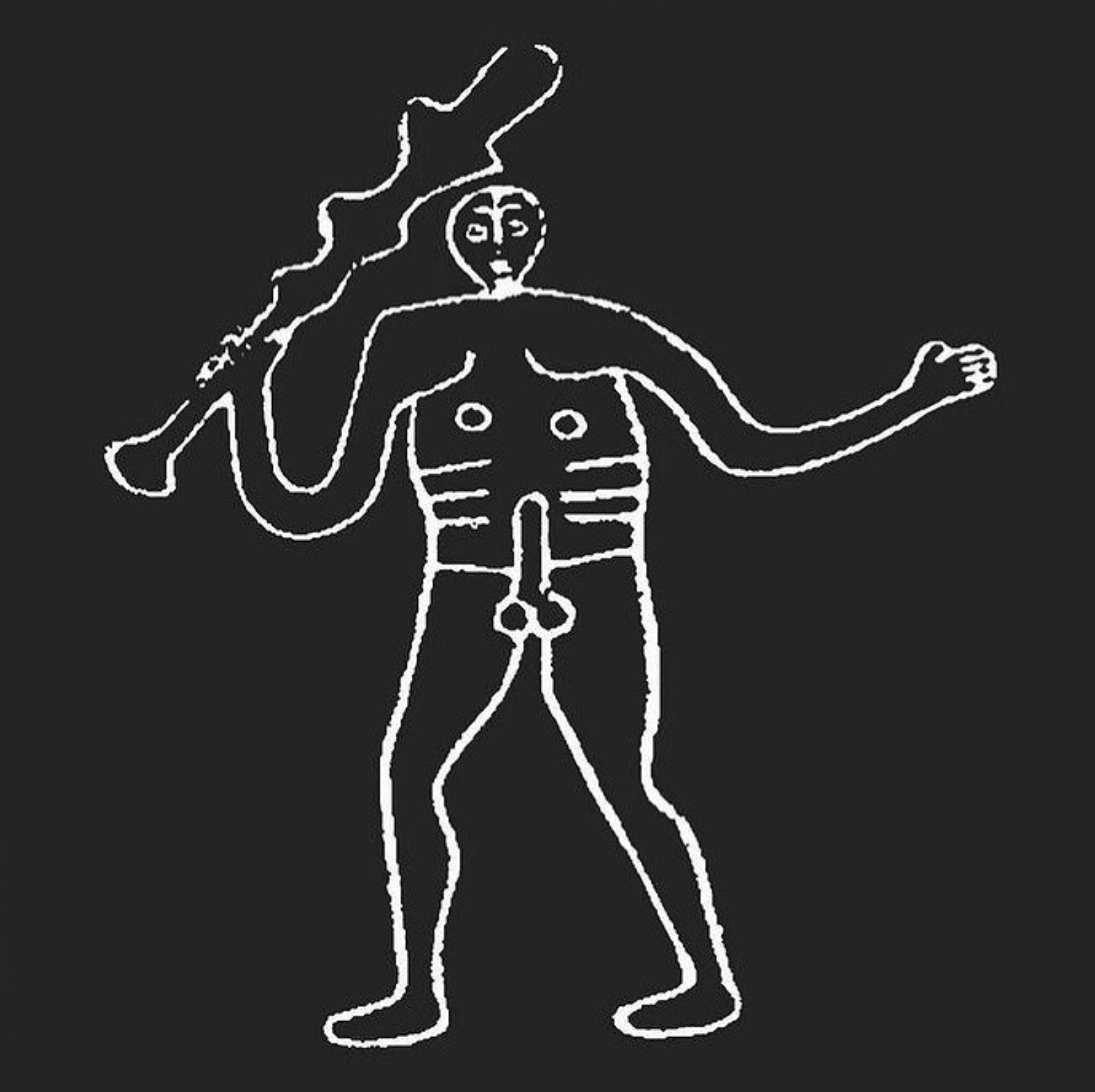

We Take Data
I found a selection of ceramics within my environment which seemed to have appeared from nowhere. They were smashed, in a variety of sizes. I looked up and wondered if they had fallen from the roof. The process included scanning them in order to document them, with the idea to curate. I randomly placed the ceramics on the scanner in order fo them to fit the screen. The random act of placement formed the final curation. Once the scanning process had finished I then removed each object from the background. When they had been removed from the original background I then place the object back into a separate blank file with a black background. This was when the yellow sticker was placed within the frame, to indicate to myself which object had already moved. I found this extra human interaction an interesting element. Likened to when archaeologist mark a fossil once it has been examined.
“We take data and document where we are and what we do and what nature is doing. we accumulate photographs and records to compensate that sense of irremediable loss for the passing traveller.” The Sky On Location (1983) dir. Babette Mangolte

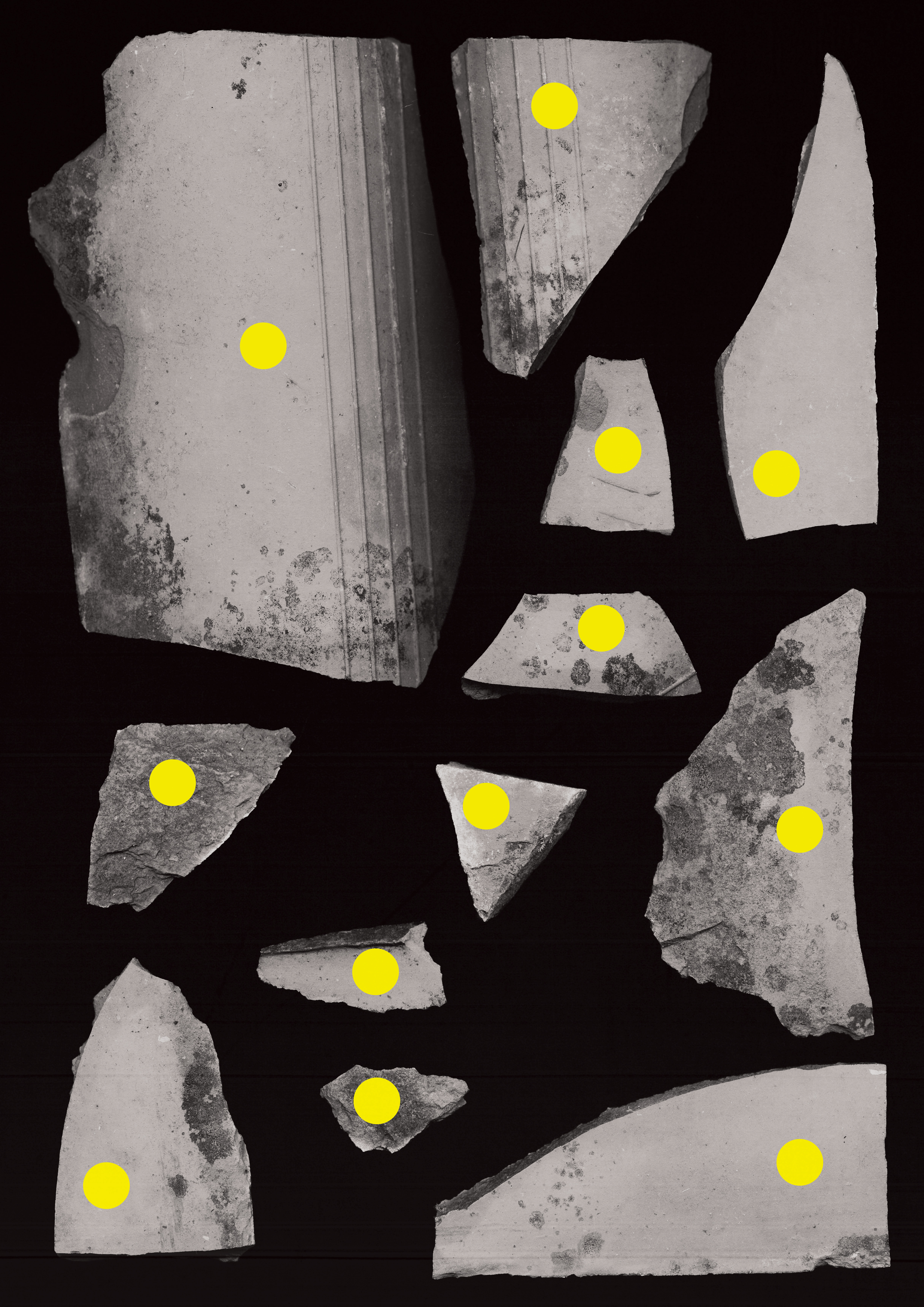
Anne Greene & Arjan de Nooy

︎
Last updated 10/01/2023